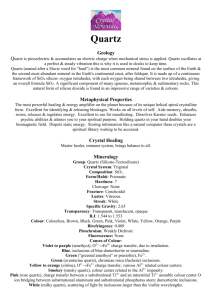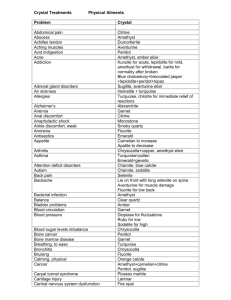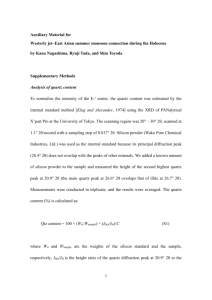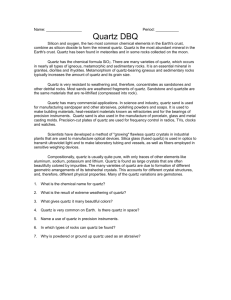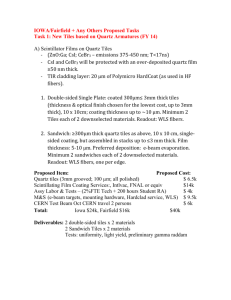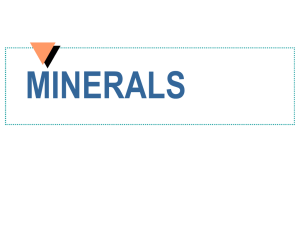Alternative Minerals-Potential for Guyana (Part 2)
advertisement
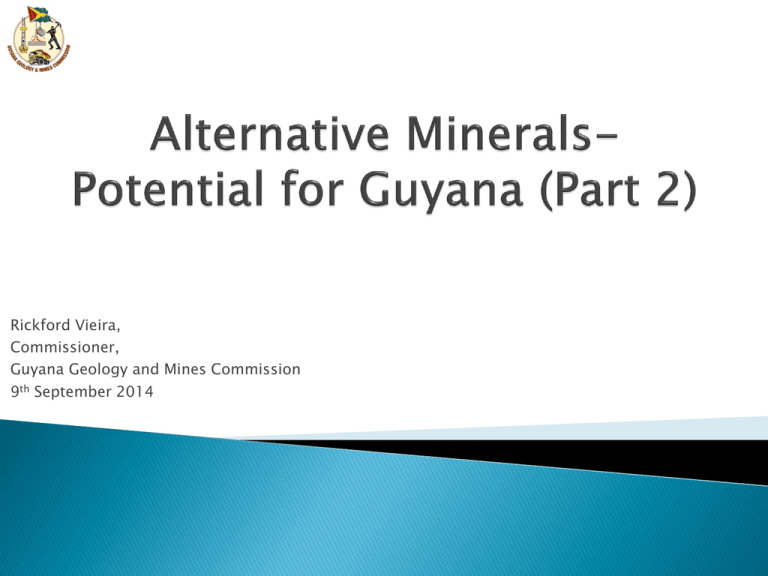
Rickford Vieira, Commissioner, Guyana Geology and Mines Commission 9th September 2014 Chromite occurs in layered ultramafic intrusive rocks. It is found in metamorphic rocks such as some serpentinites. Ore deposits of chromite form as early magmatic differentiates. Chromite occurrence was found in Coral Snake Creek of the Pomeroon River Head Chromite is used as a refractory material because it has a high heat stability. Chromite is used in chrome plating and alloying for production of corrosion resistant super alloys, nichrome, and stainless steel. Chromium is used as a pigment for glass, glazes, and paint, and as an oxidizing agent for tanning leather. Stainless Steel Pigment for Glass Muscovite is the most common mica. It is founded in granites, pegmatites, gneisses, and schists or as a secondary mineral resulting from the alteration of topaz, feldspar and kyanite. In pegmatites, it is often found in immense sheets that are commercially valuable. Mica occurrences were found in Moruka River Head and Kartabu Point. Mica is stable when exposed to electricity, light, moisture, and extreme temperatures. It is use in the electronic and electrical industries as insulators and capacitors It provides increased resistance to water penetration and weathering, and brightens the tone of colored pigments It reduces cracking and chalking, prevents shrinkage and shearing of the paint film Electrical Insulators Colored Pigments Cassiterite(Sn) forms in high-temperature veins and usually related to igneous rocks such as granites and rhyolites. When rocks containing cassiterite (Sn) are weathered the cassiterite tends to remain intact, and eventually is concentrated in streams to form “placer” occurrences Tin occurrence was found in Potaro River Area Mowasi River Area and the Kuyuwini Granites Tin takes a high polish and is used to coat other metals to prevent corrosion Alloys of tin are important, such as soft solder, pewter, bronze and phosphor bronze. The most important tin salt used is tin(II) chloride which is used as a reducing agent. Tin salts sprayed onto glass are used to produce electrically conductive coatings. Most window glass is made by floating molten glass on molten tin to produce a flat surface. Recently, a tin-niobium alloy that is superconductive at very low temperatures has attracted interest. For its High Sheen (Luster) Reducing Agent Generally, greenstone belts host economical deposits of many metals, including gold, manganese, uranium and copper. Groete Creek copper occurrence is associated with the interbedded metasedimentary and metavolcanic rocks. The major applications of copper are as follow: ◦ ◦ ◦ ◦ Electrical wires and Electronic components (60%). Roofing and plumbing (20%) Industrial machinery (15%). Copper alloy (5%) Electrical Alloy of Zinc and Copper Copper Tubes Iron ore potential in Guyana can be separated into two main types: ◦ Lateritic deposits ◦ Non-lateritic deposits Non lateritic iron ore can be separated in two types: ◦ Banded iron formations and ◦ Possible magmatic derived magnetite deposits containing titanium. The major applications of Iron are as follow: ◦ ◦ ◦ ◦ ◦ ◦ Buildings and Highway construction. Vehicle Manufacturing Industrial Machinery Household and Institutional Furnishing Pharmaceuticals Recreational facilities In Construction Industry In Recreational Sport ( Golf Club) Amethyst is a purple variety of quartz (SiO2) and owes its violet color to irradiation, iron impurities (in some cases in conjunction with transition element impurities), and the presence of trace elements, which result in complex crystal lattice substitutions. Amethyst occurs in primary hues from a light pinkish violet to a deep purple. Amethyst may exhibit one or both secondary hues, red and blue. Amethyst – Facts and Formation Pictures showing Amethyst in Guyana Location :Rupununi : Dadanawa ranch and Aishalton Village Best Field Indicator : Hardness : 7 Colour : Violet or purple *** Note: Hardness: 1 is lowest and 10 is highest. Manufacturing of watches and handbags. Manufacturing of counter tops. Amethyst generates far-infrared radiation. Amethyst generates negative ion emission. Amethyst is used as gemstones in Jewelry. Amethyst is used protection, and healing stones. Amethyst is used in the manufacturing of drinking vessels and massage tools. Agate- is a cryptocrystalline variety of silica, chiefly chalcedony, characterized by its fineness of grain and brightness of color. Although agates may be found in various kinds of rock, they are classically associated with volcanic rocks and can be common in certain metamorphic rocks Most agates occur as nodules in volcanic rocks or ancient lavas, in former cavities produced by volatiles in the original molten mass, which were then filled, wholly or partially, by siliceous matter deposited in regular layers upon the walls. Agate has also been known to fill veins or cracks in volcanic or altered rock underlain by granitic intrusive masses. Such agates, when cut transversely, exhibit a succession of parallel lines, often of extreme tenuity, giving a banded appearance to the section. Such stones are known as banded agate, riband agate and striped agate. Pictures showing Agates found in Guyana Location: North Rupununi: Ireng River around Sunnyside Best Field Indicator : Hardness : 7 Colour : White to grey, light blue, orange to red, black. Structure : Regular layers / Bands *** Note: Hardness: 1 is lowest and 10 is highest. Uses: jewellery, counter tops, bookends, wind chimes, and other decorative items. Deposits of banded and fire agate occur in the North Rupununi savannahs in the southwest of Guyana. The best deposits are found in Bon Millee on an old terrace of the left bank of the Ireng River in the North Rupununi savannahs, approximately 31 miles north of Lethem. Likewise in a gravel bed deposit at Sishwa, 4 miles down the Ireng River from Bon Millee. Quartz is the second most abundant mineral in the Earth's continental crust, after feldspar. It is made up of a continuous framework of SiO4 silicon–oxygen tetra-hedra, with each oxygen being shared between two tetra-hedra, giving an overall formula SiO2. Rose quartz is a type of quartz which exhibits a pale pink to rose red hue. The color is usually considered as due to trace amounts of titanium, iron, or manganese, in the massive material. Some rose quartz contains microscopic rutile needles which produces an asterism in transmitted light. Recent X-ray diffraction studies suggest that the color is due to thin microscopic fibers of possibly dumortierite within the massive quartz. Rose quartz is a type of quartz which exhibits a pale pink to rose red hue. The color is usually considered as due to trace amounts of titanium, iron, or manganese, in the massive material. Rose quartz is usually very evenly colored. Pictures showing Rose Quartz found in Guyana Location : Dadanawa Ranch area of South Rupununi Best Field Indicator : Hardness : 7 Colour : Clear crystals of quartz with pink to reddish pink Rose quartz has been used as a gemstone and as other ornamental and religious objects. Green Quartz is clear to opaque and coloured by a variety of minerals including Iron, nickle, copper, chlorite and actinolite. Green-quartz or vermarine is a green form of quartz, a silicate mineral chemically silicon dioxide. Prasiolite is one of several quartz varieties. Green quartz is sometimes incorrectly called green amethyst. True Green Quartz is fairly rare. Green quartz has been used as counter tops, jewelry, gemstone and as other ornamental and religious objects.
